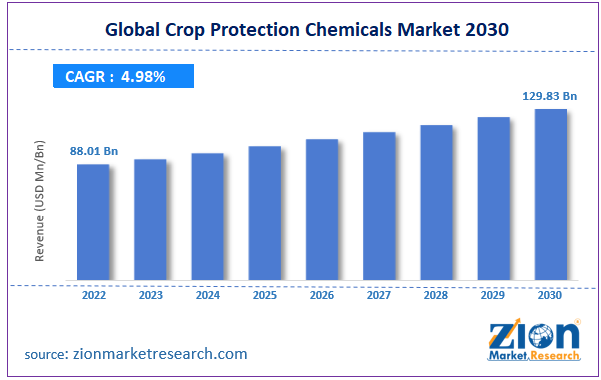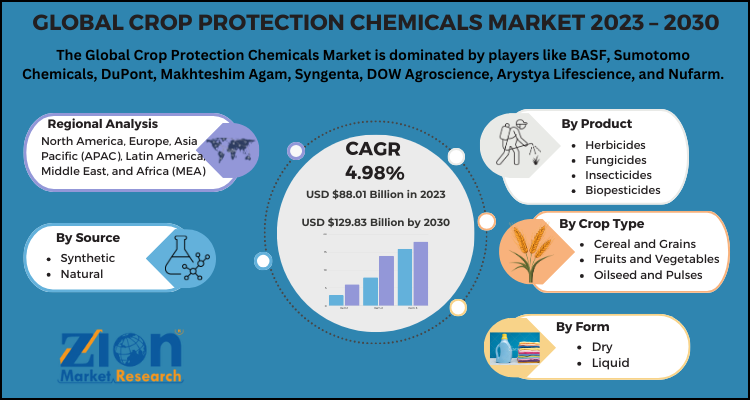Global Crop Protection Chemicals Market: Overview
The global Crop Protection Chemicals Market size was worth around USD 88.01 Billion in 2022 and is predicted to grow to around USD 129.83 Billion? by 2030 with a compound annual growth rate (CAGR) of roughly 4.98% between 2023 and 2030.
To Get more Insights, Request a Free Sample
Crop protection is the practice implemented to protect the crop from weeds, plant diseases, and other pests. The crop may get damage due to bacteria, rodents, insects, birds, and others. These agricultural crops include wheat, maize, rice, vegetable crops, fruits, and others. There is an increased demand from growing population for the food, security, and evaluation of farming from traditional to conventional practices. Use of crop protection chemicals has risen in the crop field in order to enhance productivity. They are extensively adopted across the world to reduce crop loss and improve crop yield in order to meet the requirement of food demand for increasing population. Hence, many market players are accepting crop protection chemicals on large scale. Crop protection chemicals include insecticides, herbicides, and fungicides that kill a wide variety of pests.
Crop protection chemicals are a mixture of numerous chemicals, which possess harmful and toxic elements that may pollute the environment. These chemicals can lead to many health issues such as cancer, skin infection, lung infection, and others. Thus, governments have issued extensive guidelines for its use and consumption in crop fields. However, many research activities are underway to discover a less harmful substitute to crop protection chemicals such as pesticides. This may inhibit the growth of the crop protection chemicals market across the globe.
Global Crop Protection Chemicals Market: Growth Factors
Strict regulations on the usage of persistent organic pollutants (POPs) have led to the increased use of environment-friendly insecticides such as pyrethroid and pyrethrums, which have minimal impact on the environment. Rising demand for food security in order to meet growing population requirement with the limited agricultural land available in the world is positively impacting the global crop protection chemicals market growth. Moreover, loss in the crop production due to pest attack has increased the use of crop protection chemicals. Conversely, use of the DDT has been banned in framing as it acts agricultural land pollutant and poses severe risks to human and animal health.

To Get more Insights, Request a Free Sample
Global Crop Protection Chemicals Market: Segmentation
The global crop protection chemicals market is classified based on crop type as fruits & vegetables, cereals & oilseeds, and others. On the basis of type, the global market is fragmented as fungicides, herbicides, insecticides, and others. Of these, herbicides segment is the leading segment in the global market due to increasing use in the farming. In addition, they are capable of killing various herbs and unwanted weeds in order to reduce the crop loss. Moreover, the global crop protection chemicals market is categorized based on origin as biopesticides, and synthetic. Furthermore, based on the application, the global market is classified as soya bean, cereals & grain rice, fruits, vegetables and nuts, oilseeds & pulses rapeseed, sugarcane, corn, cotton, wheat, and others.
Global Crop Protection Chemicals Market: Regional Analysis
Growth in biofuel crops farming in Latin America may boost the global crop protection chemicals market in this region in the coming future. They are sourced from energy crops such as sugarcane, wheat, rapeseed, corn, and soybean. Asia Pacific is also growing at a fast rate in the global market as demand for biofuels is reducing the dependence on conventional fuels and their imports, hence driving the global market. However, restriction on the usage of persistent organic pollutants is expected to drive the global crop protection chemicals market growth in the near future in Asia Pacific. They are useful for environmental degradation. Moreover, developing countries such as Chile, Brazil, and Argentina highly prefer biofuel.
Crop Protection Chemicals Market: Report Scope
| Report Attributes | Report Details |
|---|---|
| Report Name | Crop Protection Chemicals Market Size Report |
| Market Size in 2022 | USD 88.01 Billion |
| Market Forecast in 2030 | USD 129.83 Billion |
| Growth Rate | CAGR of 4.98% |
| Number of Pages | 188 |
| Forecast Units | Value (USD Billion), and Volume (Units) |
| Key Companies Covered | BASF, Sumotomo Chemicals, DuPont, Makhteshim Agam, Syngenta, DOW Agroscience, Arystya Lifescience, and Nufarm. |
| Segments Covered | By Source,By Product, By Crop Type, By Form and By region. |
| Base Year | 2022 |
| Historical Year | 2017 to 2021 |
| Forecast Year | 2023 - 2030 |
| Customization Scope | Avail customized purchase options to meet your exact research needs. Request For Customization |
Global Crop Protection Chemicals Market: Competitive Players
Most companies are focusing on improving their presence in emerging as well as potential markets such as Asia Pacific and Central & South America by entering into strategic collaborations and establishing new plants. For instance, In October 2020, Nufarm Ltd combined Australian and New Zealand businesses with Asia businesses to create an Asia Pacific business. Asia Pacific business incorporates crop protection operations in Australia, New Zealand, and South-East Asia. This was made to improve the supply chain, efficiency, and manufacturing capabilities, and develop opportunities across the region. Some of the prominent players in the global crop protection chemicals market include:
Major companies operating in the global crop protection chemicals market are -
- BASF
- Sumotomo Chemicals
- DuPont
- Makhteshim Agam
- Syngenta
- DOW Agroscience
- Arystya Lifescience
- Nufarm.
By Product :
- Herbicides
- Fungicides
- Insecticides
- Biopesticides
By source:
- Synthetic
- Natural
By Crop Type:
- Cereal and Grains
- Fruits and Vegetables
- Oilseed and Pulses
By Form:
- Dry
- Liquid
Global Crop Protection Chemicals Market: Regional Segment Analysis
- North America
- U.S.
- Europe
- UK
- France
- Germany
- Asia Pacific
- China
- Japan
- India
- Latin America
- Brazil
- The Middle East and Africa
What Report Provides
- Full in-depth analysis of the parent market
- Important changes in market dynamics
- Segmentation details of the market
- Former, on-going, and projected market analysis in terms of volume and value
- Assessment of niche industry developments
- Market share analysis
- Key strategies of major players
- Emerging segments and regional markets
- Testimonials to companies in order to fortify their foothold in the market.
Frequently Asked Questions
Table Of Content
Inquiry For Buying
Crop Protection Chemicals
Request Sample
Crop Protection Chemicals

